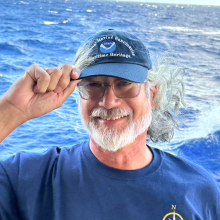
Hans Van Tilburg
Tell us about your work/research. What kinds of things do you do?
I am a maritime archaeologist and historian supporting the national marine sanctuary system in the survey, assessment, and preservation of underwater cultural heritage resources within the sanctuary boundaries and elsewhere under US federal jurisdiction. Often this means the investigation of submerged shipwrecks and sunken aircraft, but there are many other significant types of properties as well, including indigenous fish weirs and coastal fishponds, former wharves and coastal landing sites, nearshore infrastructure and more. Many of these sites face impacts from coastal development or environmental and climate change impacts, and so decisions must be made on what is important, what can or should be studied, preserved and protected. I've been a principal investigator for 30+ site projects throughout the Hawaiian archipelago, American Samoa and Alaska, employing diving, remotely operated vehicles, and manned submersible operations.
What sparked your initial interest in your career?
I was raised sailing with my father along the California coast and (having watched too many episodes of Seahunt with Lloyd Bridges as Mike Nelson) became a diver at a young age, and so had a natural interest in maritime history and the ocean. Later, I was surprised to learn, during my previous career as a carpenter in San Francisco, that the field of underwater archaeology even existed (!), and so I signed up for an experiential field course and caught the maritime archaeology bug. My interest in the Asia Pacific region coincided with my mother's family history in the Hawaiian Islands, and so my wife and I eventually moved to O`ahu, where I led university certificate courses in maritime archaeology and history. We still have a long way to go to understand all our cultural and historical connections to the ocean. The sea, like the land, holds a physical record of our past.
Who influenced you or encouraged you the most?
The field of maritime archaeology is relatively young and quite multidisciplinary, and there are a number of very important and influential characters associated with it. I must say, Dr. William Still (founded East Carolina University's Maritime Studies Program with Dr. Gordon Watts) was most encouraging to me, instilling a deep respect for maritime history in all its forms.
What element of your work/study do you think is the most fascinating?
The challenge of discovering history within the ocean, and the many ways we engage culturally with the sea, are what fascinate me most.
How did you get involved with the Ocean Exploration Trust?
NOAA's Office of National Marine Sanctuaries partners with Ocean Exploration Trust on a number of significant maritime archaeological projects, so it is a pleasure to get to take part in this mission.
What other jobs led you to your current career?
It's curiosity about the mysteries of the deep, literally, that led me to my current career. Shipwrecks are scenes of accidents and sometimes tragedies, their stories often untold until the somewhat forensic application of archaeological science is applied. My past experiences as a diver (a sport diving instructor, a science diver at UC Berkeley, East Carolina University, and University of Hawai`i, a commercial diver for a brief period in the Gulf of Mexico) helped.
What are your degrees and certifications?
Sport diving instructor (National Association of Underwater Instructors) 1983; Bachelor of Arts in Geography - University of California Berkeley 1985; Master of Arts in Nautical Archaeology and Maritime History - East Carolina University 1995; Doctor of Philosophy in History - University of Hawaii 2002; Commercial Air surface-supplied diver - College of Oceaneering 1985; Unit Diving Supervisor - National Oceanic and Atmospheric Administration 2006; Instructor Foundation Underwater Cultural Heritage courses - UNESCO 2010
What are your hobbies?
I've been a diver for more than 50 years, so (and in some ways I'm sorry to say this) when I go on vacation, I head for backpacking in the wilderness, and might be found somewhere far away on the Continental Divide Trail, the Arizona Trail, or sections on some other national long-distance treks. In Hawaii I also garden, cook Chinese food, take care of the dogs, etc.
What advice would you give someone who wants to have a career like yours?
My general advice to students is to follow your passion...do what interests you! That way, you're guaranteed to have an interesting life. For those who are looking towards the maritime archaeology field, realize that the field touches on a diverse array of associated aspects, such as: ocean engineering, marine surveying, archaeology, history, museums and exhibits, materials conservation, cultural resource management, outreach and education, and more. It might be a relatively small field, but it has broad potential.
Expeditions
Hans participated in the following Ocean Exploration Trust expeditions:
